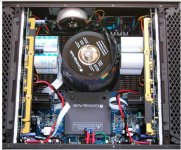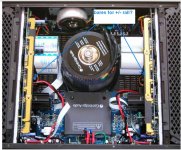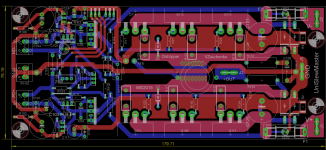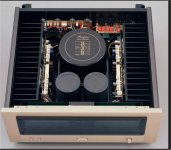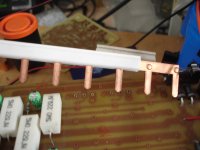2sa1295
230V
17A
MJL4281
350V
15A
2A makes that much difference?
Those are only 2 factors. The larger heat spreader and SOA of the MT-200
mean at X dissipation , the thermal derating is far less , also giving greater soa.
The 1295 will still be 200W device @ 50C while the MJL will be a 125W one.
Every 10C is >25W.
The smaller slug of the MJL means the chip (die) , is also that much warmer than the heatsink.
Edit - like a modern CPU "heatspreader"....
ON does not even give a thermal derating plot. Sanken does.
The curve of the SOA is different on the sanken , it truly has a higher
current rating @ >70V.
The wattage and amperage rating on both are for <30C and low voltage(<40V). Here they are similar.
At 70V and 50C , the sanken is 2:1 over the ON.
OS
Last edited:
I see. Well I still have a pile of Onsemi devices so I doubt I will be trying the Sankens any time soon. I also already have 3 pair of MJL 5p OPS, one pair of IRFP 5P OPS, one pair of MJL 2P IPS and 3 pair of the LFET mini OPS. I also have the Tubsumo 2p OPS and now Borys' 3P OPS. Not really sure I'll have a need for more. You guys must be doing some serious partying if you are putting 5 pair of MJL4283/4302 in danger. I will have to check the bias on the individual outputs to see if I have having the same issues you are.
Blessings, Terry
Blessings, Terry
Then with the extra space left over near the fuses , reposition and
allow for a 16-18mm main decoupling caps.
18mm is still the same 7.5mm LS and can be 2400uf@ 63V/1800@80/1K-100.
16mm can be 1800/1200/820u.
Those electrolytics at the output collectors are not essential. If they are too
small , your rails will "ring".
My idea for these on the slew V1.x came from the edmond stuart "camp".
They used no main decoupling , Just 4 smd 100-100V units at the collectors.
No inductance before the collector pads.
Omit them and just use a big 1Kuf at the beginning of a 30A Imax rail , you
would see the same signal at the collectors.
The secondary decoupling that feeds the driver/pre-driver rail is 4.7R -10R
plus a 47-470uf R/C combo. (below 1) green = R/C at drivers , red= the cap multiplier output.
The multiplier is a real good edition (below 2)green = input pair pssr , red= the final amp output after NFB.
This with a CFA !!! -120db is very good. That is why no slewmaster blows
up. Also , the ops is the best to compare with ... as CFA and VFA are
both have quite low PSRR. Some VFA's can drop to -150db using the multiplier.
OS
On the layout, main cap are already 18mm.....
Marc
You are quite correct , terry.
I could only forsee a "hungry sub" like the Dayton HO or ultimax being
able to chew on this kind of power.
A full range speaker would either blow or make you deaf.
I did find one amp (below) , that not only uses 5 pair MT-200 ....
but is laid out nearly exactly to the Slew 2.0.
They really conservatively rate it at 250/380W , but you can bridge it
for 500/1000. Usually , most recommend double the outputs for a bridge.
Not here. I suspect the small toroid and power supply "collapses" to
bring the single channel power down. Or, it has lower rails.
Nice amp .... regardless (Cambridge audio).
OS
I could only forsee a "hungry sub" like the Dayton HO or ultimax being
able to chew on this kind of power.
A full range speaker would either blow or make you deaf.
I did find one amp (below) , that not only uses 5 pair MT-200 ....
but is laid out nearly exactly to the Slew 2.0.
They really conservatively rate it at 250/380W , but you can bridge it
for 500/1000. Usually , most recommend double the outputs for a bridge.
Not here. I suspect the small toroid and power supply "collapses" to
bring the single channel power down. Or, it has lower rails.
Nice amp .... regardless (Cambridge audio).
OS
Attachments
Are these bares for +/- rail?
I found the schema's. The "bares" are +/-70V. They go N/P/N/P/N , bottom
is P/N/P/N/P (outputs). "Bares" are underneath , as well.
Full loop cancellation. But they have drivers/pre/ and IPS right in between
those rails (they HAD to do it).
Caps are 4X -12,000uf per channel , BTW. Another amp that falls into the
slewmaster design "scope".
OS
OS,
So they ran those power rails that way to keep the pcb narrower than they would have had to otherwise or was that so they could run the power rails all stacked for some cancellation effects such as you would do with a double sided board with plus and minus rail on top of each other?
So they ran those power rails that way to keep the pcb narrower than they would have had to otherwise or was that so they could run the power rails all stacked for some cancellation effects such as you would do with a double sided board with plus and minus rail on top of each other?
OS,
So they ran those power rails that way to keep the pcb narrower than they would have had to otherwise or was that so they could run the power rails all stacked for some cancellation effects such as you would do with a double sided board with plus and minus rail on top of each other?
Most likely for both reasons. The amp specs out real good. No fancy
stuff , just 2 big amps and control circuitry/PS.
I've also seen accuphase do this. (below)
Kind , I'm surprised you think a sub has to be "muddy" ?
Phase is the Key. Unlimited depth and "wow" factor , if tuned and phased.
OS
Attachments
OS,
I'm not implying that a sub can't work well but the majority of the ones I've heard have been terrible, just pumping air in very narrow bands. The majority are cheap commodity speaker junk as far as I see, not saying there aren't some better designs but they are the outlier in my eyes. I've been able to get down into the lower 35hz range with my speaker designs so haven't had to deal with integrating another speaker to produce those lows, that has been low enough to satisfy me and anyone I have demo'd the speakers to. I have played with bandpass enclosures years ago and didn't like the shape of the bandpass they put out, required to much eq to flatten them out. I'm not much on listening to movie soundtracks so more interested in listening to music. If I ever need to make a bunch of low bass I have a 21" driver sitting in storage that would easily do that, I just find things falling off the walls and things rattling kind of annoying!
I'm not implying that a sub can't work well but the majority of the ones I've heard have been terrible, just pumping air in very narrow bands. The majority are cheap commodity speaker junk as far as I see, not saying there aren't some better designs but they are the outlier in my eyes. I've been able to get down into the lower 35hz range with my speaker designs so haven't had to deal with integrating another speaker to produce those lows, that has been low enough to satisfy me and anyone I have demo'd the speakers to. I have played with bandpass enclosures years ago and didn't like the shape of the bandpass they put out, required to much eq to flatten them out. I'm not much on listening to movie soundtracks so more interested in listening to music. If I ever need to make a bunch of low bass I have a 21" driver sitting in storage that would easily do that, I just find things falling off the walls and things rattling kind of annoying!
I wonder how much you have to de-rate those heatsinks when you place them inside the enclosure like that. unless of course both the top and bottom panels are open over those areas which I doubt they are doing? Bu open I mean not a bunch of punched holes in the top and bottom but clearly open areas allowing good heat movement.
What would you say if we use this?Most likely for both reasons. The amp specs out real good. No fancy
stuff , just 2 big amps and control circuitry/PS.
I've also seen accuphase do this. (below)
Kind , I'm surprised you think a sub has to be "muddy" ?
Phase is the Key. Unlimited depth and "wow" factor , if tuned and phased.
OS
Attachments
I'm not implying that a sub can't work well but the majority of the ones I've heard have been terrible, just pumping air in very narrow bands.
So are you talking car audio ? Poorly designed isobaric 45hz bandpass driven
by a class D.
A proper "audiophile" sub is -3db @ 25hz - 100hz. Nice and flat.
At normal listening levels , it pumps NO air. It's almost "not there".
It's larger driver (with more Xmax) is only moving a couple mm (thd <1%).
The smaller stereo pair bass driver would have to work much harder.
And simultaneously reproduce vocals.
The paradigm's with multiple 7" drivers actually did the <40hz - 600hz
Very very well ... but they cost 3K$. This experience can be recreated
easily with 200$ bookshelves and that proper sub.
OS
What would you say if we use this?
Yeah !! 😱😱
But a "normal" diy'er might not have that level of access ?
If you do , you will essentially be eliminating L and R. They use one
continuous piece , you might want to solder the rivets.
OS
I think it is Geddes who recommends multiple subs distributed around the room to even out the room modes and have better integration with the main speakers. Getting that low sound to match the main speakers and work with the room is not a simple problem.
But a "normal" diy'er might not have that level of access ?
OS
That is available in electrical shops (I hope it's a good phrase in english). This is for MCBs, and available for 40, 80, 120A...
Sajti
That is available in electrical shops (I hope it's a good phrase in english). This is for MCBs, and available for 40, 80, 120A...
Sajti
I found 3 phase version, which can be +rail, -rail, and output/ground in sigle piece 🙂
Sajti
I find most cheaper subs boomy and artificial sounding. Usually because the owner is overdriving an underpowered amp into them. This is why I'm building my own. I think the key to a good sub is mainly a good amplifier that doesn't run our of power supply. The Slew amp I put together makes my cheap ACI drivers sound great.
Car audio subs are supposed to be better these days, but I think they actually were better 20 years ago when we used free air drivers or large cabinets and a good AB amp. Back then we used to put together systems to sound good, not break windshields though.
Car audio subs are supposed to be better these days, but I think they actually were better 20 years ago when we used free air drivers or large cabinets and a good AB amp. Back then we used to put together systems to sound good, not break windshields though.
JW,
Yes I remember those days, people would ask me to make speakers for cars, I wouldn't do it, to many returns when those guys would burn voice-coils and tear them up, it was generally only about how loud they could get and nothing to do with great sound. I had a horn loaded three way system in my car with hand made crossovers and pro-audio bass drivers. Three amps in the trunk, two I still have sitting somewhere, Monolithic's I think they were called and it had a parametric eq to go with them. I had a third stereo amp just for the bass section, took up lots of trunk space.
Yes I remember those days, people would ask me to make speakers for cars, I wouldn't do it, to many returns when those guys would burn voice-coils and tear them up, it was generally only about how loud they could get and nothing to do with great sound. I had a horn loaded three way system in my car with hand made crossovers and pro-audio bass drivers. Three amps in the trunk, two I still have sitting somewhere, Monolithic's I think they were called and it had a parametric eq to go with them. I had a third stereo amp just for the bass section, took up lots of trunk space.
- Home
- Amplifiers
- Solid State
- Slewmaster - CFA vs. VFA "Rumble"
